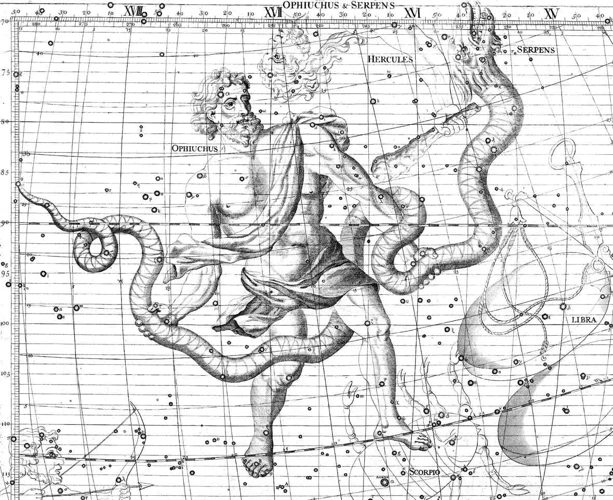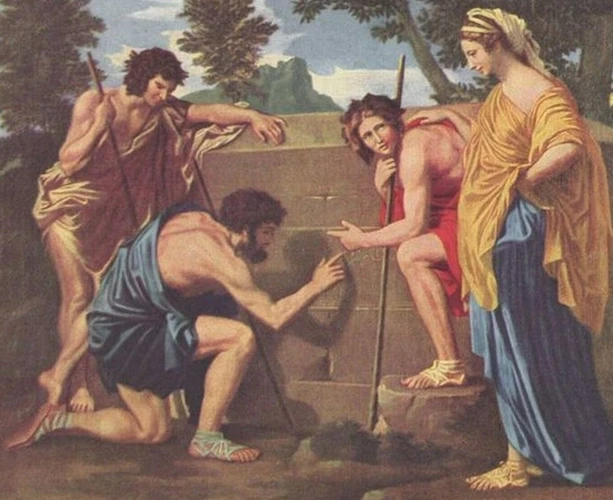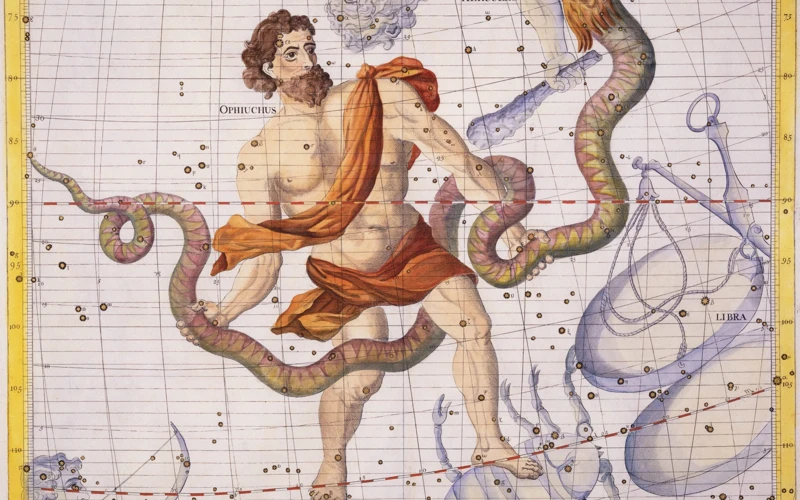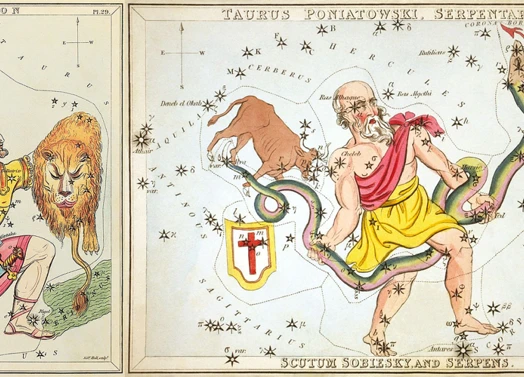Unveiling the Mysterious Sign of Ophiuchus: A Journey through Centuries of Cultural Significance
Welcome to the fascinating world of Ophiuchus, an enigmatic constellation that has intrigued mankind throughout history. Often referred to as the “Serpent Bearer,” Ophiuchus has had a profound impact on various ancient civilizations, medieval astrological traditions, and modern pop culture. In this captivating exploration, we will delve into the origins of Ophiuchus, its role in ancient civilizations such as Mesopotamia and Egypt, its significance in the Hellenistic astrology of ancient Greece, its prominence in medieval European, Islamic, Chinese, and Indian astrological traditions, and its presence in contemporary astrological systems, literature, art, film, and television. Join us as we unravel the mysteries and uncover the cultural significance of Ophiuchus throughout the ages.
Contents
- Ophiuchus in Ancient Civilizations
- Ophiuchus in Medieval Times
- Ophiuchus in Modern Pop Culture
- Conclusion
-
Frequently Asked Questions
- What is the meaning of the constellation Ophiuchus?
- How did Ophiuchus influence ancient Mesopotamian culture?
- Which deity was Ophiuchus connected to in Egyptian mythology?
- What role did Ophiuchus play in Hellenistic astrology?
- How did medieval European astrology incorporate Ophiuchus?
- What influence did Islamic astrology have on Ophiuchus?
- How did Ophiuchus impact Chinese and Indian astrological traditions?
- How does Ophiuchus fit into contemporary astrological systems?
- How has Ophiuchus been portrayed in literature and art?
- What is the presence of Ophiuchus in film and television?
- References
-
Frequently Asked Questions
- What is the cultural significance of Ophiuchus throughout history?
- What are the origins of Ophiuchus?
- How did Ophiuchus feature in Mesopotamian culture?
- What was the role of Ophiuchus in Egyptian mythology?
- How did Ophiuchus influence Hellenistic astrology?
- What role did Ophiuchus play in medieval European astrology?
- How did Islamic astrology incorporate Ophiuchus?
- What significance did Ophiuchus hold in Chinese and Indian astrological traditions?
- How is Ophiuchus integrated into contemporary astrological systems?
- How has Ophiuchus been depicted in literature and art?
- References
- Read More
Ophiuchus in Ancient Civilizations

The mesmerizing presence of Ophiuchus in ancient civilizations echoes throughout the annals of history. With its origins shrouded in mystery and myth, this celestial figure captivated the imagination of cultures such as Mesopotamia and Egypt. In Mesopotamian culture, Ophiuchus was associated with the god Enki, a deity of wisdom and healing closely connected to serpents. The Egyptians, on the other hand, viewed Ophiuchus as a representation of the god Imhotep, the master physician and architect. These ancient civilizations revered Ophiuchus for its association with knowledge, wisdom, and healing, attributing divine powers to this celestial phenomenon. Anchored in their belief systems and practices, Ophiuchus played a pivotal role in shaping the spiritual and cultural landscapes of these civilizations, leaving an indelible mark on their histories and beliefs.
The Origins of Ophiuchus
The origins of Ophiuchus lie in the rich tapestry of mythology and astronomy that has fascinated civilizations for centuries. This constellation, also known as the Serpent Bearer, holds a prominent position in the zodiac, yet its inclusion in the astrological calendar is a subject of debate. According to some sources, Ophiuchus is associated with the ancient Greek figure Asclepius, the god of medicine and healing. Legend has it that Asclepius possessed the knowledge to resurrect the dead, a power that Zeus found threatening. As a result, Zeus struck him down with a thunderbolt, immortalizing Asclepius in the night sky as a constellation. This tale intertwines with the celestial serpent, symbolizing rejuvenation and rebirth. The serpents coiling around the staff of Asclepius are thought to represent healing and the intertwining paths of life and death. The significance of Ophiuchus extends beyond ancient Greece, with references to similar serpent-bearing deities found in Mesopotamian and Egyptian cultures. The origins and symbolism of Ophiuchus serve as a testament to humanity’s deep fascination with the mysteries of the cosmos, with this constellation serving as a bridge between the earthly realm and the celestial wonders above.
Ophiuchus in Mesopotamian Culture
Ophiuchus holds a significant place in Mesopotamian culture, where it was linked to the god Enki. Enki, the deity of wisdom, had strong associations with serpents, and Ophiuchus, often depicted as a serpent bearer, became closely intertwined with this god. The serpent symbolism represented rejuvenation, healing, and the acquisition of knowledge. The people of Mesopotamia believed that Enki possessed immense wisdom and was responsible for the well-being of humanity.
In Mesopotamian astronomy, Ophiuchus was known as the “Ea” constellation, and it held great importance in celestial observations. Ea, another name for Enki, was considered a major deity associated with various aspects of civilization, including arts, crafts, and knowledge. The constellation’s positioning in the sky helped astronomers and astrologers determine the changes in seasons and celestial events like solstices and equinoxes.
The inclination towards Ophiuchus in Mesopotamian culture can be seen in the many clay tablets discovered during archaeological excavations. These tablets contain records of celestial observations, astronomical charts, and omens based on the movements of celestial bodies. This demonstrates the Mesopotamians’ keen interest in deciphering the celestial world and their belief that these celestial phenomena influenced human lives and events on Earth.
The fascination with Ophiuchus in Mesopotamian culture extended beyond astronomy and astrology. The serpent symbolism, associated with this constellation, played a significant role in religious rituals and myths. Serpents were believed to possess divine power and were considered intermediaries between gods and humans. Ophiuchus represented not only healing but also protection against evil forces, as serpents were believed to possess the ability to ward off malevolent spirits.
The cultural significance of Ophiuchus in Mesopotamia reflects the deep-rooted reverence for wisdom, healing, and protection within their society. This constellation, seen as a conduit between the divine and human realms, served as a guiding force for the Mesopotamians, both in their understanding of the cosmos and their spiritual practices.
Ophiuchus in Egyptian Mythology
In Egyptian mythology, Ophiuchus held a prominent position as a representation of the god Imhotep. Imhotep was not only revered as the master physician but also as a great architect and sage. Known for his prodigious healing abilities, Imhotep was considered to be the divine source of knowledge and wisdom. Ophiuchus symbolized the connection between Imhotep and the healing arts, further solidifying its significance in Egyptian mythology. The constellation was often associated with serpents, which were believed to possess regenerative and rejuvenating properties. This link between Ophiuchus and serpents reinforced the idea of healing and divine power. Imhotep, as the embodiment of Ophiuchus, was regarded as a deity capable of providing miraculous healing and guiding others towards mental and physical well-being. The influence of Ophiuchus in Egyptian mythology extended beyond the realm of medicine, with the constellation being associated with architectural prowess as well. Imhotep’s architectural achievements, such as the Step Pyramid of Djoser, emphasized the connection between celestial knowledge and the construction of monumental structures. The presence of Ophiuchus in Egyptian mythology highlights the profound importance of wisdom, healing, and architecture in their cultural and religious beliefs.
The Greek Connection: Ophiuchus in Hellenistic Astrology
The Greek Connection: Ophiuchus in Hellenistic Astrology
In the realm of Hellenistic astrology, Ophiuchus held a unique place among the twelve zodiac signs. While not part of the traditional zodiac, Ophiuchus was acknowledged and studied by Greek astrologers who believed in its significant influence over human destinies. Ophiuchus was seen as a celestial figure embodying healing and wisdom, often associated with the god Apollo and the renowned healer Asclepius. It was believed that those born under the sign of Ophiuchus possessed remarkable healing abilities and a deep affinity for knowledge. However, the placement of Ophiuchus in the astrological system was a subject of debate among astrologers, with some aligning it with Scorpio and others considering it a standalone sign. This ambiguity and its association with both serpents and healing arts added an air of mystery to Ophiuchus within the Greek astrological framework.
To better understand the implications of Ophiuchus, we need to delve into the intricate symbolism surrounding this celestial entity. In Hellenistic astrology, Ophiuchus was often depicted as a man holding a massive serpent, representing his power to tame and control the forces of nature. This symbiotic relationship between Ophiuchus and serpents reflected the belief that the constellation’s energy harnessed the transformative and regenerative qualities of the serpent, further emphasizing its association with healing and rejuvenation.
While not as prominent as the twelve zodiac signs, Ophiuchus did find its way into Greek astrological treatises, such as the works of Ptolemy and Paulus Alexandrinus. These texts discussed Ophiuchus as an influential force that could potentially shape an individual’s life path and characteristics. Astrologers studied the position of celestial bodies in relation to Ophiuchus to gain insights into an individual’s potential for healing, wisdom, and spiritual growth.
It is worth noting that despite its recognition in Hellenistic astrology, Ophiuchus gradually faded from mainstream astrological practices over time. The focus shifted to the twelve traditional zodiac signs, relegating Ophiuchus to a more obscure and lesser-known role within astrological systems. However, its significant presence in Greek astrology ensured that Ophiuchus remained a fascinating and intriguing constellation, leaving an indelible mark on the history of astrology.
The Greek connection between Ophiuchus and Hellenistic astrology reveals a symbolic interplay of healing, wisdom, and serpents. Its position as a distinct celestial figure among the zodiac signs, though debated, showcases the significance attributed to Ophiuchus in shaping human destinies and understanding the complexities of the cosmos.
Ophiuchus in Medieval Times

In the rich tapestry of medieval times, Ophiuchus continued to weave its celestial influence. In medieval European astrology, Ophiuchus found its place among the twelve Zodiac signs, standing alongside familiar figures like Aries, Taurus, and Pisces. While not as widely recognized as the other signs, Ophiuchus held a special significance for those who studied the stars and their influence on human affairs. Islamic astrology, heavily influenced by ancient Greek and Persian traditions, also embraced Ophiuchus as an important celestial entity. It played a role in shaping astrological charts and predictions, offering insights into character traits, destiny, and compatibility. Meanwhile, in the Far East, both Chinese and Indian astrological traditions acknowledged the presence of Ophiuchus, incorporating it into their astrological systems. These diverse interpretations and beliefs surrounding Ophiuchus during medieval times reflect its enduring prominence and cultural significance transcending geographic boundaries and eras.
Ophiuchus in Medieval European Astrology
Ophiuchus in Medieval European Astrology:
In the realm of medieval European astrology, Ophiuchus held a unique and mysterious position. While the twelve zodiac signs known today were widely recognized during this time, Ophiuchus was not included as one of them. However, it did have some influence and presence in astrological practices of that era. Ophiuchus was treated as a celestial figure residing between the constellations of Scorpio and Sagittarius, often depicted as a man grasping a serpent. It was believed that Ophiuchus possessed knowledge and powers related to healing and medicine. Some medieval astrologers associated Ophiuchus with Asclepius, the Greek god of medicine, considering it to be a symbol of expertise in the healing arts. Ophiuchus was also occasionally interpreted as a representation of the biblical figure of Joseph, with the serpent symbolizing his enslavement and subsequent rise to power. Despite its somewhat marginal status, Ophiuchus left its mark on medieval European astrology, adding an intriguing layer of symbolism and interpretation to the astrological landscape of the time.
The Influence of Islamic Astrology
Islamic astrology, also known as Arabic astrology, arose during the Islamic Golden Age and exerted a significant influence on the development of astrological thought. It drew upon the Hellenistic and Persian astrological traditions, incorporating various elements to create its unique system. The influence of Islamic astrology extended beyond the realm of celestial divination and encompassed diverse fields such as medicine, architecture, and agriculture.
In Islamic astrology, Ophiuchus held a revered position as one of the twelve major zodiacal signs, each associated with different personality traits and astrological predictions. Within this system, Ophiuchus was often regarded as dynamic and versatile, imbuing individuals born under its influence with the qualities of curiosity, intellect, and innovation. Islamic astrologers believed that this celestial figure had the power to grant individuals with a strong sense of intuition, making them skilled problem solvers and investigators.
The knowledge and practice of Islamic astrology spread throughout the Islamic world, from the Persian Empire to North Africa and Spain. Prominent scholars such as Abu Ma’shar al-Balkhi and Al-Kindi made important contributions in the field, further enhancing the influence of Islamic astrology. Astrology played a significant role in Islamic society, informing decisions related to marriage, governance, and agriculture. The impact of Islamic astrology can still be seen in the architecture of Islamic buildings, where astrological symbolism is often incorporated into the design.
It is worth noting that while astrology was widely practiced and respected within Islamic culture, skepticism also existed. Some scholars cautioned against excessive reliance on astrological predictions, emphasizing the importance of free will and the power of God’s guidance. Nevertheless, Islamic astrology left an indelible mark on the intellectual and cultural landscape of the Islamic world, influencing thinking, art, and daily life for centuries.
The influence of Islamic astrology, including the role of Ophiuchus within it, shaped various aspects of Islamic society and contributed to the rich tapestry of astrological traditions. The fusion of ancient knowledge and Islamic philosophical thought resulted in a unique and enduring legacy that continues to fascinate scholars and enthusiasts alike.
Chinese and Indian Astrological Traditions
Chinese and Indian astrological traditions have long recognized the significance of Ophiuchus in their respective systems. In Chinese astrology, Ophiuchus is associated with the Snake, one of the 12 animal signs of the zodiac. Individuals born under the sign of the Snake are believed to possess qualities such as wisdom, intuition, and mystery. The Snake is considered a powerful symbol representing transformation and healing, traits often attributed to Ophiuchus as well.
In Indian astrology, Ophiuchus is linked to the Nakshatra (lunar mansion) known as Ashlesha. Ashlesha is represented by a coiled snake and is associated with transformation, secret knowledge, and hidden wisdom. People born under the influence of Ashlesha are believed to possess great intuition, charm, and the ability to navigate through life’s complexities.
Both Chinese and Indian astrology recognize the intricate connection between Ophiuchus and serpents, which symbolize wisdom and transformation. The inclusion of Ophiuchus in these astrological traditions demonstrates the universal recognition of its cultural significance and its impact on the understanding of human personality traits and the interpretation of celestial events.
To summarize the importance of Ophiuchus in Chinese and Indian astrology:
- In Chinese astrology, Ophiuchus is associated with the Snake sign, representing wisdom and transformation.
- In Indian astrology, Ophiuchus is linked to the Nakshatra Ashlesha, symbolizing hidden wisdom and secret knowledge.
Ophiuchus in Modern Pop Culture

From ancient times to the present day, Ophiuchus has maintained a significant presence in modern pop culture, manifesting itself in various aspects of our contemporary world. In contemporary astrological systems, Ophiuchus has garnered attention as the 13th zodiac sign. While its inclusion has been a subject of debate, many individuals identify with the characteristics associated with Ophiuchus, such as their natural healing abilities and profound wisdom. Ophiuchus has found its way into literature and art, with authors and artists harnessing its allure to add depth and intrigue to their creations. In the realm of film and television, Ophiuchus has made appearances, often as a symbolic or mysterious figure, helping to enhance the narrative and evoke a sense of mysticism. Whether in astrology, literature, art, or entertainment, Ophiuchus continues to captivate and inspire, leaving an indelible mark in modern pop culture.
- Astrological Systems: Ophiuchus as the 13th zodiac sign.
- Literature and Art: Incorporation of Ophiuchus in creative works.
- Film and Television: Depiction of Ophiuchus as a symbolic or mysterious figure.
Ophiuchus in Contemporary Astrological Systems
In contemporary astrological systems, the inclusion of Ophiuchus has been a matter of much debate and speculation. While the traditional zodiac consists of twelve signs, the emergence of Ophiuchus as a potential thirteenth sign has sparked interest and controversy among astrologers and enthusiasts. Proponents of the addition argue that Ophiuchus brings fresh perspectives and energies to astrological interpretations, offering a new dimension to personal horoscopes. They believe that individuals born between November 29 and December 17 may resonate with the attributes attributed to Ophiuchus, such as being intuitive, insightful, and driven by a thirst for knowledge. However, critics dismiss the inclusion of Ophiuchus, suggesting that it disrupts the established system and renders previous astrological calculations invalid. They argue that the traditional zodiac, based on Babylonian and Greek traditions, remains the most accurate representation of celestial alignments. Despite the ongoing debate, the concept of Ophiuchus in contemporary astrology continues to intrigue both skeptics and enthusiasts, highlighting the ever-evolving nature of astrological systems.
Ophiuchus in Literature and Art
Ophiuchus’s captivating presence has not only left an imprint on ancient civilizations and astrological traditions but has also permeated the realms of literature and art. Throughout history, numerous literary works have incorporated references to Ophiuchus, showcasing its symbolic significance. In some cases, Ophiuchus has been portrayed as a protagonist or hero, embodying the qualities of wisdom, healing, and enlightenment. These representations highlight the enduring fascination with this celestial figure and its association with the pursuit of knowledge.
Artistic depictions of Ophiuchus further amplify its cultural significance. From ancient sculptures and murals to Renaissance paintings and contemporary works, Ophiuchus has been portrayed in various forms and interpretations. Artists often utilize visual symbols such as serpents, staffs, and celestial motifs to represent Ophiuchus in their artwork. These representations reflect the diverse interpretations and meanings associated with this celestial entity. Ophiuchus’s presence in literature and art seamlessly intertwines with its rich mythological and astrological symbolism, making it a subject of fascination and inspiration for creators across different artistic mediums.
Ophiuchus in Film and Television
Ophiuchus has left an indelible mark on the world of film and television, captivating audiences with its mystique and symbolism. This intriguing constellation has made its presence known in various ways, from featuring as a prominent character to being referenced symbolically. One notable example of Ophiuchus in film is the 2011 fantasy adventure film “Immortals,” where the character Theseus, portrayed by Henry Cavill, is depicted as an Ophiuchus-like figure, embodying strength and healing abilities. In the popular television series “American Horror Story: Freak Show,” the character named Penny, played by Grace Gummer, sports an Ophiuchus tattoo on her arm, symbolizing rebellion and transformation. Ophiuchus has also found its way into the world of anime with the character Shiryu from the iconic series “Saint Seiya” donning the Ophiuchus Gold Cloth, representing healing and restoration. These instances in film and television not only showcase the influence of Ophiuchus in popular culture but also highlight its significance as a symbol of power, healing, and transformation.
| Examples in Film and Television | |
|---|---|
| “Immortals” (2011) | The character Theseus, played by Henry Cavill, embodies Ophiuchus-like qualities, symbolizing strength and healing abilities. |
| “American Horror Story: Freak Show” | Grace Gummer’s character, Penny, sports an Ophiuchus tattoo symbolizing rebellion and transformation. |
| “Saint Seiya” | In this anime series, the character Shiryu wears the Ophiuchus Gold Cloth, representing healing and restoration. |
Conclusion

In conclusion, the cultural significance of Ophiuchus spans centuries and continents, leaving a lasting impact on ancient civilizations, medieval astrological traditions, and modern popular culture. Throughout history, Ophiuchus has been revered as a symbol of wisdom, healing, and divine knowledge. From its origins in Mesopotamia and its association with the gods of healing and wisdom, to its presence in Egyptian mythology and its role in Hellenistic astrology, Ophiuchus has captivated the human imagination. In medieval times, it continued to be an important figure in European astrology, while simultaneously influencing Islamic, Chinese, and Indian astrological traditions. In contemporary times, Ophiuchus has found its place in modern astrological systems, literature, art, film, and television, gaining recognition and popularity. Its mystique and allure continue to fascinate enthusiasts, researchers, and artists alike, only deepening its cultural significance. Ophiuchus, the Serpent Bearer, stands as a testament to the enduring power of celestial wonders and their profound impact on human culture throughout history.
Ultimately, the exploration of Ophiuchus reveals the interconnectedness of humanity and the cosmos, as well as our eternal fascination with the mysteries of the universe. As we continue to unveil the secrets of our celestial surroundings, Ophiuchus serves as a reminder of the vast cultural tapestry that spans across time and space. Whether it be ancient civilizations finding solace in its healing energies or modern-day artists breathing life into its symbolism, Ophiuchus remains an emblem of humanity’s quest for wisdom, knowledge, and understanding. Let us celebrate and appreciate the cultural significance of Ophiuchus, a celestial figure that transcends boundaries and unites us in our shared fascination with the wonders of the universe.
Frequently Asked Questions

What is the meaning of the constellation Ophiuchus?
Ophiuchus, often referred to as the “Serpent Bearer,” symbolizes various themes such as wisdom, healing, and the acquisition of knowledge. It represents the power of rejuvenation and transformation.
How did Ophiuchus influence ancient Mesopotamian culture?
In Mesopotamia, Ophiuchus was associated with the god Enki, who was revered as a deity of wisdom, healing, and the arts. The constellation’s presence influenced their understanding of medicine, astrology, and the importance of serpents in their belief systems.
Which deity was Ophiuchus connected to in Egyptian mythology?
Ophiuchus was associated with the god Imhotep in Egyptian mythology. Imhotep was considered the master physician, architect, and a high priest of the sun god Ra. Ophiuchus symbolized the divine powers of healing and knowledge.
What role did Ophiuchus play in Hellenistic astrology?
In Hellenistic astrology, Ophiuchus was recognized as one of the thirteen zodiac constellations. It influenced the interpretation of birth charts and added complexity to astrological readings by representing qualities such as introspection, rebirth, and transformation.
How did medieval European astrology incorporate Ophiuchus?
Medieval European astrology acknowledged Ophiuchus as a significant constellation, often associated with healing, herbalism, and the search for hidden knowledge. It was believed to bring forth individuals with profound healing abilities and a deep connection to the spiritual realm.
What influence did Islamic astrology have on Ophiuchus?
Islamic astrology played a key role in preserving and expanding the knowledge of the constellations, including Ophiuchus. Islamic scholars explored the connections between celestial bodies, human nature, and fate, further enriching their understanding of Ophiuchus within astrological practices.
How did Ophiuchus impact Chinese and Indian astrological traditions?
In Chinese astrology, Ophiuchus was not recognized as a zodiac sign but was associated with the constellation of the Serpent. In Indian astrology, references to Ophiuchus can be found in ancient texts, especially in the context of planetary movements and their effects on an individual’s destiny.
How does Ophiuchus fit into contemporary astrological systems?
In contemporary astrological systems, Ophiuchus is a subject of debate. While it is not recognized as a traditional zodiac sign, some astrologers integrate it into their readings as a thirteenth sign, bringing forth themes of healing, spiritual transformation, and the pursuit of knowledge.
How has Ophiuchus been portrayed in literature and art?
Ophiuchus has been a source of inspiration in literature and art throughout history. It is often depicted as a mystic figure, interwoven with serpents, embodying wisdom, and the healing arts. Artists and writers have used Ophiuchus as a symbol of transformation, knowledge, and the pursuit of higher truths.
What is the presence of Ophiuchus in film and television?
Ophiuchus has made appearances in various films and television shows, sometimes as a character or a representation of mystical and transformative qualities. Its connection to healing and knowledge has been creatively explored in different narratives, adding depth and intrigue to storytelling.
References
- Ophiuchus – The Constellations
- Ophiuchus: (not) the 13th ‘Sign’
- Ophiuchus: Facts about the Snake Bearer
Frequently Asked Questions

What is the cultural significance of Ophiuchus throughout history?
The cultural significance of Ophiuchus throughout history is vast and varied. This constellation has played a role in ancient civilizations, medieval times, and modern pop culture, influencing different aspects of society such as astrology, mythology, literature, and art.
What are the origins of Ophiuchus?
The origins of Ophiuchus can be traced back to ancient civilizations such as Mesopotamia, Egypt, and Greece. It is believed to have originated as a way to interpret and understand the celestial movements and their impact on human existence.
How did Ophiuchus feature in Mesopotamian culture?
In Mesopotamian culture, Ophiuchus was associated with the figure of Enki, the god of wisdom, creation, and healing. This constellation was seen as a representation of Enki’s role as a divine healer and caretaker of humanity.
What was the role of Ophiuchus in Egyptian mythology?
In Egyptian mythology, Ophiuchus was closely associated with the god Imhotep, who was considered the patron of medicine and healing. It was believed that Imhotep possessed great knowledge and the ability to cure diseases, which led to his association with this constellation.
How did Ophiuchus influence Hellenistic astrology?
In Hellenistic astrology, Ophiuchus was added as the 13th zodiac sign, representing a blend of the traits of Scorpio and Sagittarius. This addition was done to align the astrological system with the 12-month calendar, but it did not gain widespread acceptance.
What role did Ophiuchus play in medieval European astrology?
In medieval European astrology, Ophiuchus was largely overlooked or assimilated with other constellations. It did not receive the same level of recognition as the traditional 12 zodiac signs. However, it did have some influence on esoteric astrological practices.
How did Islamic astrology incorporate Ophiuchus?
Islamic astrology drew inspiration from various cultural influences, including ancient Greek and Persian traditions. While Ophiuchus was not explicitly mentioned in Islamic astrology, some interpretations of celestial phenomena and horoscopes incorporated elements that correspond to this constellation.
What significance did Ophiuchus hold in Chinese and Indian astrological traditions?
In Chinese and Indian astrological traditions, Ophiuchus does not hold as prominent a position as in Western astrology. These traditions focus more on animals and elements as symbols in their respective zodiac systems.
How is Ophiuchus integrated into contemporary astrological systems?
In contemporary astrological systems, Ophiuchus is not universally recognized as a zodiac sign. However, some astrologers have embraced it, considering it as an additional sign and exploring its potential influence on personality traits and horoscope interpretations.
How has Ophiuchus been depicted in literature and art?
Ophiuchus has been depicted in literature and art in various ways, often as a healer or wise figure. In literature, this constellation has been incorporated into fictional stories and poems, while in art, it has been represented through paintings, sculptures, and other visual mediums.







